Development of ICON-SmART Earth System Model

ICON includes component models for the atmosphere (ICON-A), the ocean together with sea-ice (ICON-O), the land (ICON-L) and chemistry (ICON-ART), which can be used as separate models, or coupled together as a earth-system model with the option to include the full carbon cycle, bio-geochemical processes in the ocean and complex treatment of land processes. ICON-Seamless-ART (ICON-SmART) addresses the role of aerosols and atmospheric chemistry for the simulation of seasonal to decadal climate variability and change. This Earth system model will enhance the capabilities of the coupled composition, weather and climate modelling system ICON-ART (ICON, icosahedral nonhydrostatic model – developed by DWD, MPI-M and DKRZ with the atmospheric composition module ART, aerosols and reactive trace gases – developed by KIT) for seasonal to decadal predictions and climate projections in seamless global to regional model configurations. This will provide scientists, forecasters and policy-makers with a tool to investigate atmospheric composition in a changing climate and allows us to answer questions that have been previously out of reach.
ICON ICON-ART ICON-SmARTAcceleration of weather/climate forecasting models using Machine Learning

Aerosols affect weather and climate by absorbing and scattering radiation. Such effects strongly depend on the optical properties of aerosols that are mainly controlled by their other characteristics like size distribution, morphology and chemical composition. Chemistry and aerosol microphysics constantly modify these characteristics causing a large spatial and temporal variability. Most atmospheric models cannot account for this variability as they rely on look-up table to treat aerosol optics. This simplification can lead to large errors in weather and climate models when it comes to aerosol radiative impacts.
I am developing a novel and computationally inexpensive machine learning approach for online representation of the aerosol optical properties. These properties are fully coupled with the chemical and microphysical variability of particles. I am implementing this approach in ICON-ART model.
EGU2023 Abstract arXiv 2023 NatureStudy of Geophysical phenomena using XAI and Causal Machine Learning

The discovery of causal structures behind a phenomenon under investigation has been at the heart of scientific inquiry since the beginning. In the absence of interventional data, we are forced to depend only on observational data for causal analysis. With the limited ability of traditional correlation-based computational methods to discover causal relationships, Causal Machine Learning (CML) approaches (under Granger and Pearl Causality framework) are gaining popularity. I employ different XAI and CML approaches to study geophysical phenomena and identify causal linkages.
NPJ2023 Paper JEM2023 Paper RSC2022 PaperInvestigation of stratospheric ozone loss in polar regions
First proposed by Molina and Rowland in early 1970s (Rowland and Molina won Nobel prize for Chemistry in 1995 along with Paul Crutzen), stratospheric ozone hole in the Antarctic region due to chemical destruction involving halogen compounds is very well known. Ozone hole has resulted in significant changes in southern hemispheric climate in the past decades (Gillett and Thompson, 2003; Thompson et al., 2011). It resulted in enactment of an international treaty, popularly known as Montreal Protocol, adopted on September 16, 1987 in Montreal. Montreal Protocol aimed to protect the stratospheric ozone layer by controlling the global emissions of ozone depleting substances (ODS). Due to the decrease in atmospheric loading of ODSs which has peaked around 2000 (Velders et al., 2007), the Antarctic ozone hole is expected to be on mend since 2000.
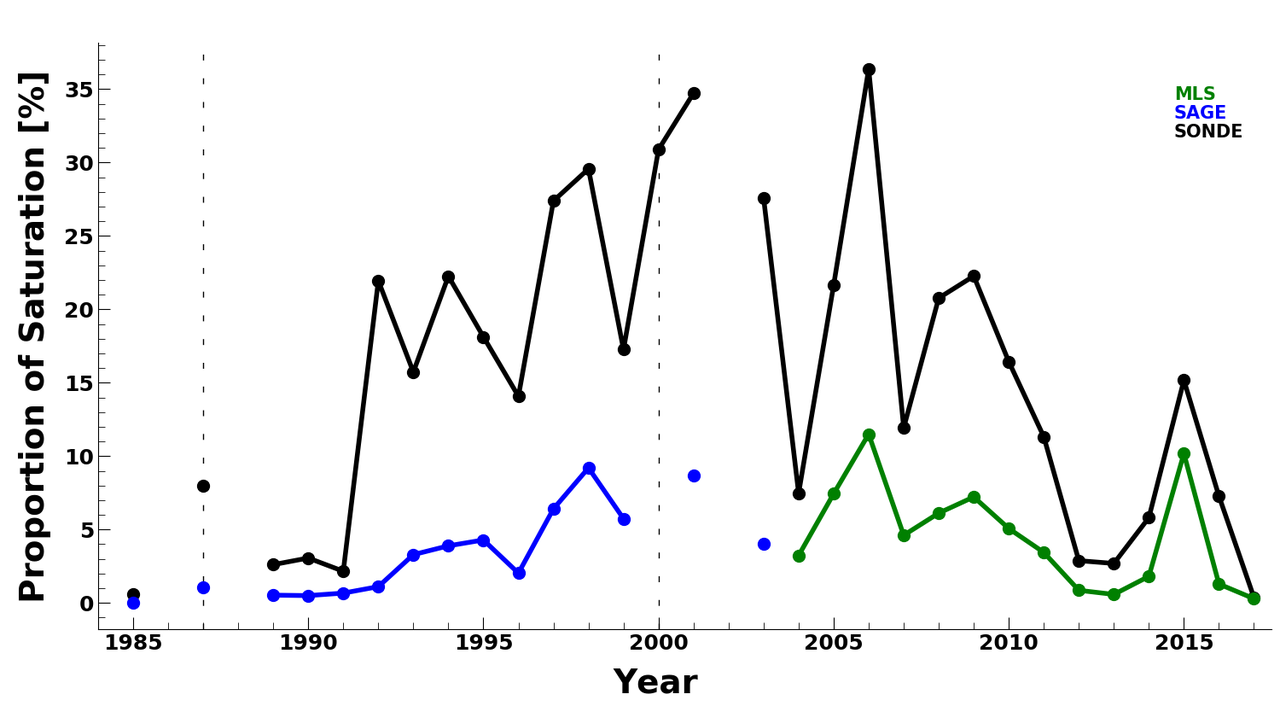
Emergence of ozone recovery evidenced by reduction in the occurrence of Antarctic ozone loss saturation
A number of studies have already reported the early signs of the healing of ozone hole (Solomon et al., 2016; Kuttippurath et al., 2017). However, there has not been any study reporting the healing in saturation layers. Ozone hole saturation layers are the atmospheric layers in the lower stratosphere (13-21 km from the sea level) where the complete destruction of ozone occurs. In this study, we have reported the comprehensive analysis of vertical, spatial and temporal evolution of ozone loss saturation within the Antarctic polar vortex using high resolution measurements during 1979-2017. Our analysis reveals that the loss saturation started in 1987 and have occurred in all winters thereafter, except a few winters of 1988 and 2002 when major stratospheric warmings occurred. We show a clear reduction in the occurrence of ozone loss saturation during 2001-2017; consistent throughout various datasets (ozonesonde and satellite observations of ozone profiles and total column ozone).
Full Text PDF Summary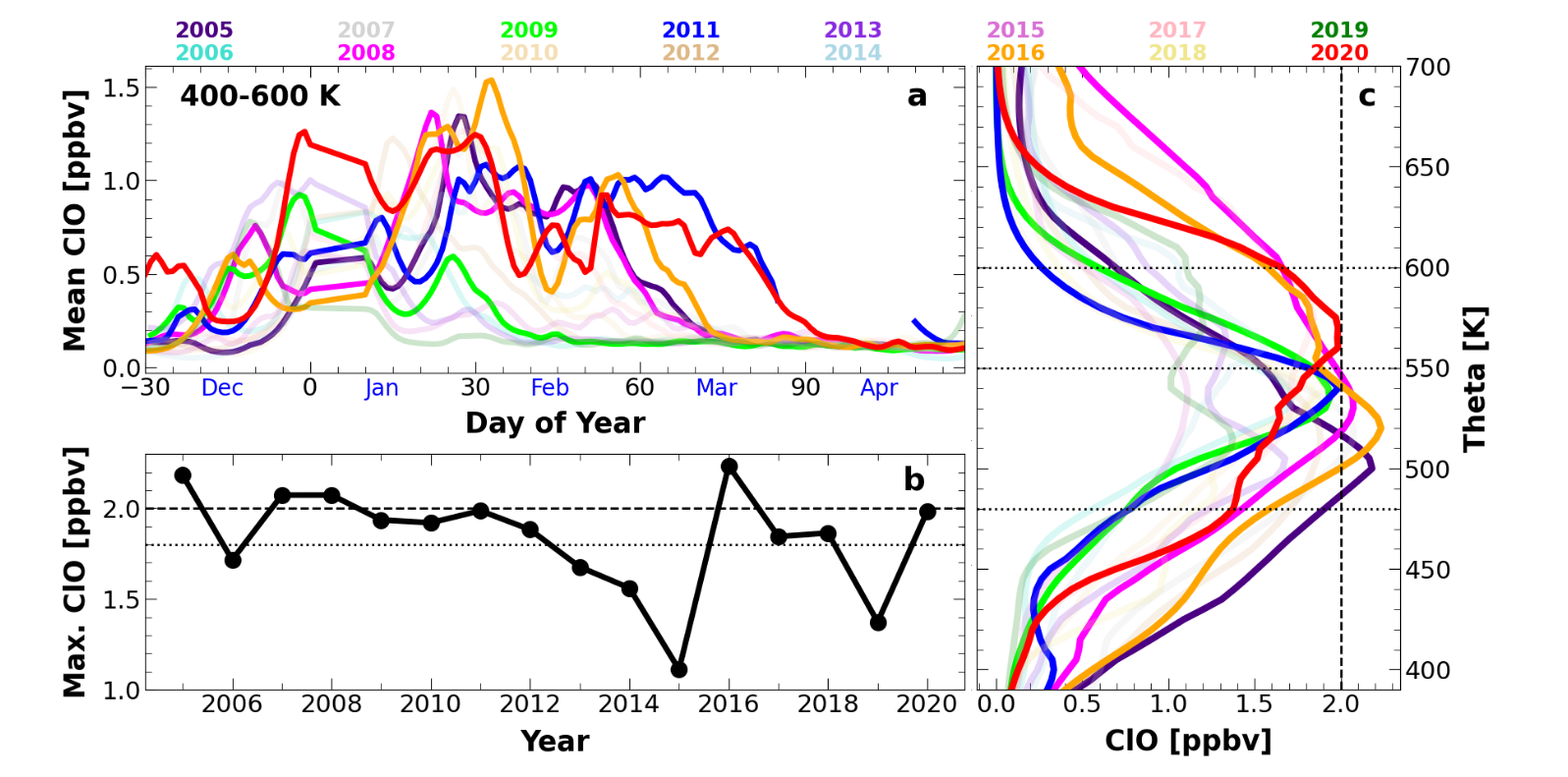
Arctic on the verge of an ozone hole?
Severe vortex-wide ozone loss in the Arctic would expose nearly 650 million people and ecosystem to unhealthy ultra-violet radiation levels. Adding to these worries, clear signature of an ozone hole (ozone column values below 220 DU) appeared over the Arctic in March and April 2020. Sporadic occurrences of ozone hole values at different regions of vortex for almost three weeks were found for the first time in the observed history in the Arctic. Furthermore, a record-breaking ozone loss of about 2.0–3.4 ppmv triggered by an unprecedented chlorine activation (1.5–2.2 ppbv) matching to the levels of Antarctic ozone hole conditions was also observed. The polar processing situation led to the first-ever appearance of loss saturation in the Arctic. Apart from these, there were also ozone-mini holes in December 2019 and January 2020 driven by atmospheric dynamics. Our study suggests that the very colder Arctic winters in near future would also very likely to experience even more ozone loss and encounter ozone hole situations, provided the stratospheric chlorine levels still stay high there.
Preprint PDF SummaryAnalysis of long-term changes in tropospheric ozone in Antarctica
With severe impacts on human health and agricultural output, tropospheric ozone is a prominent air pollutant and greenhouse gas. However, tropospheric ozone is not only a greenhouse gas and biological irritant but also an atmospheric cleansing agent which rids the atmosphere off hazardous gases through production of hydroxyl radicals and is beneficial if it is present in the stratosphere in abundant amount as it prevents harmful sun rays from penetrating through the troposphere to the Earth’s surface. Tropospheric ozone exerts considerable radiative forcing too with recent estimate being 360 mW/m2 which is 25% of the same exerted by CO2.
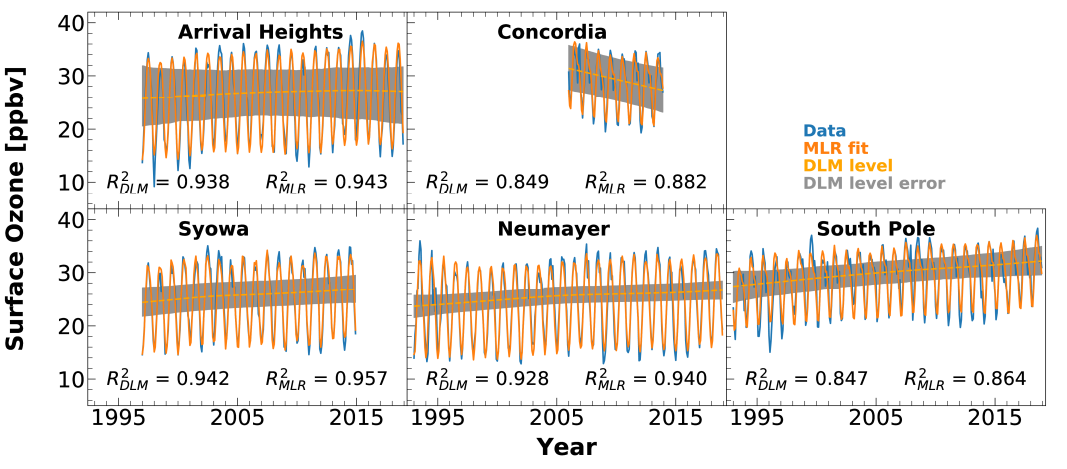
The Increasing Surface Ozone and Tropospheric Ozone in Antarctica and Their Possible Drivers
A comprehensive analysis of the temporal evolution of tropospheric ozone in Antarctica using more than 25 years of surface ozone and ozonesonde measurements reveals significant changes in tropospheric ozone there. It shows a positive trend in ozone at the surface and lower and mid-troposphere, but a negative trend in the upper troposphere. We also find significant links between different climate modes and tropospheric ozone in Antarctica and observe that changes in residual overturning circulation, the strength of the polar vortex, and stratosphere–troposphere exchange make noticeable variability in tropospheric ozone. Therefore, this study alerts of increasing ozone concentration in Antarctica, which would have a profound impact on the future climate of the region as tropospheric ozone has warming feedback to the Earth’s climate.
Full Text Summary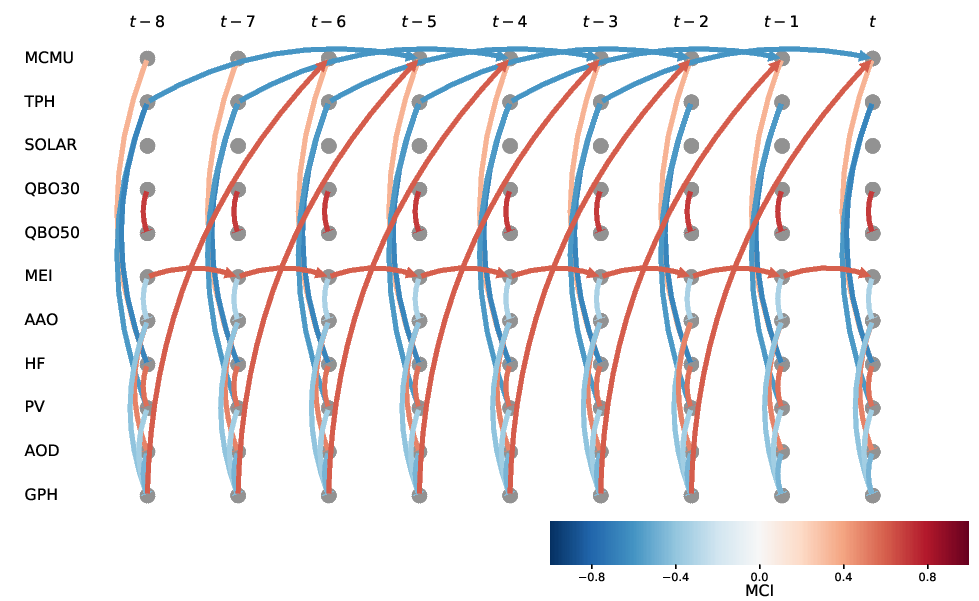
Causal Network Analysis of Chemistry and Climate Interactions
Atmospheric chemistry is closely coupled with both local and global atmospheric dynamics. Understanding these interactions is an essential prerequisite for diagnosing the influence of weather/climate on atmospheric chemistry and vice-versa. I am developing and utilising state-of-the-art causal discovery methods for reconstructing the causal dependency structure underlying chemistry–atmosphere interactions. I am also analysing the climatic impacts of changes in tropospheric ozone in Antarctic region and its geophysical drivers with the help of a suite of statistical, machine learning and physical modeling techniques.
Full Text PDF SummaryTrajectory Analysis and Receptor Modeling
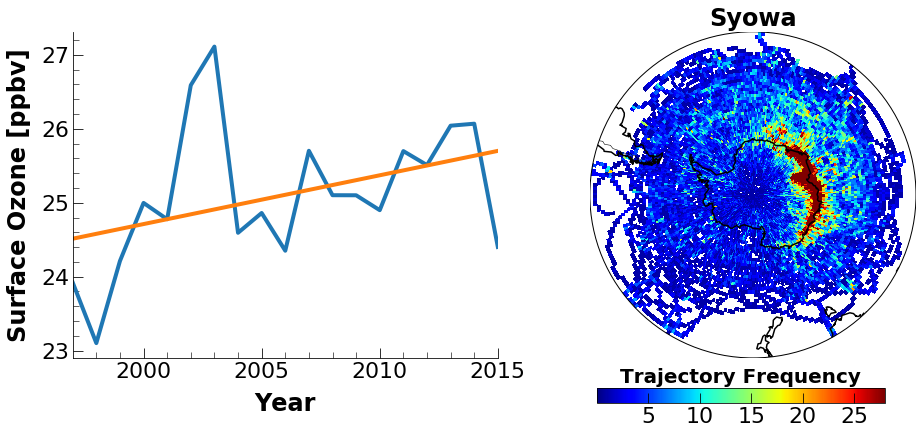
Movement of airmass, both on the planetary and local scale, can have huge impact on the chemical composition of the atmosphere. While the problem of fluid movement is generally viewed from the Eulerian perspective, Lagrangian approach is generally more useful when analysing the air-parcel movement from one region to another. Trajectory analysis has proved useful in a number of problems ranging from aircraft path analysis to identification of the sources of pollution.
I am working on the trajectories data mining using machine learning and receptor models like Potential Source Contribution Function (PSCF), Concentration Weighted Trajectories (CWT), Residence Time Weighted Concentration (RTWC) etc.
GitHub ES&T Paper ESPI Paper